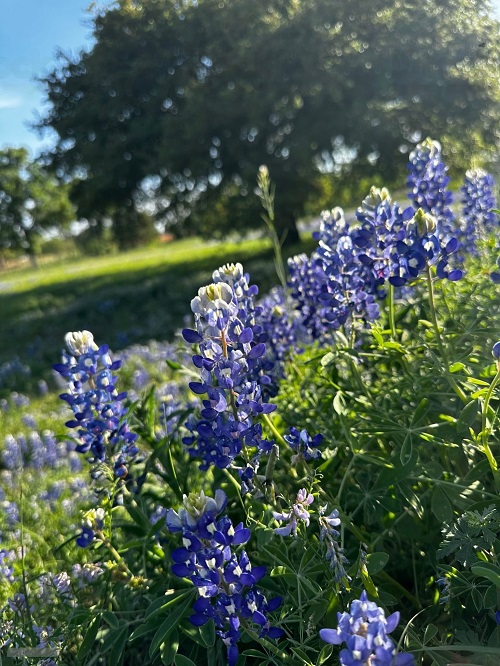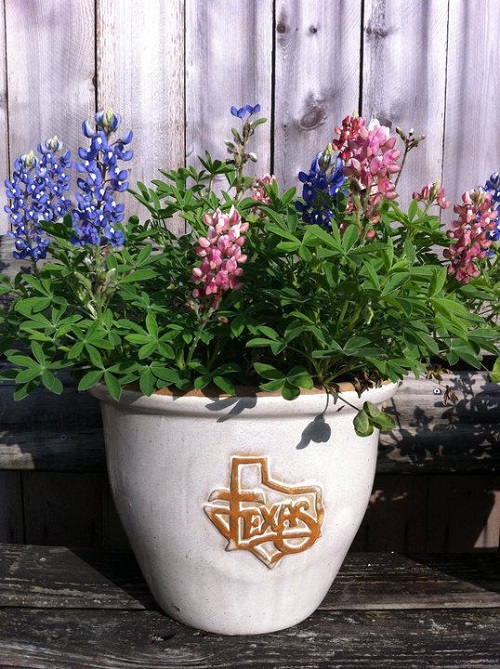Do you know about the Texas State Flower? If you don’t have any idea, then here are all the details along with growing it!

Do you know about the Texas State Flower? Well, it is a beautiful blooming plant with blue flowers! Read on to know all the details!
Learn How to Grow Texas Star Hibiscus here
Texas State Flower Information
The official Texas State Flower is the bluebonnet (Lupinus texensis). The bluebonnet is a beautiful and vibrant wildflower that holds significant cultural and historical importance in the state of Texas.
On March 7, 1901, Texas chose Lupinus subcarnosus as its state flower. But many Texans loved Lupinus texensis more. So, in 1971, the Texas Legislature decided that any similar type of Lupinus found in Texas would be considered the state flower.
- Appearance: The Texas State Flower is a member of the Lupine family and is characterized by its unique blue-to-purple color. The flower’s name, “bluebonnet,” originates from its shape, which resembles the bonnet worn by early pioneer women to shield them from the sun. The bluebonnet plant typically grows to a height of about 1 to 2 feet (30 to 60 cm) and produces tall, slender stems with clusters of blue flowers.
- Blooming Season: Bluebonnets typically bloom in Texas from mid-March to mid-April, although the exact timing can vary depending on weather conditions and geographic location. During this period, vast fields of bluebonnets can be seen carpeting the landscape, creating a breathtaking sight for residents and visitors alike.
- Significance: The bluebonnet holds a special place in the hearts of Texans and is considered a symbol of the state’s natural beauty and resilience. It is deeply ingrained in Texas culture and has become an iconic representation of the state’s wildflower heritage. The flower’s early spring bloom also serves as a sign of hope and renewal, as it signifies the end of winter and the beginning of warmer, more pleasant days.
- Cultural Impact: The Texas State Flower‘s cultural significance is evident in various aspects of Texan life. It has been the subject of countless paintings, photographs, and poems, capturing the imagination of artists and writers throughout the years. Texas children often participate in the tradition of taking pictures in bluebonnet fields, creating cherished family memories.
- Legislation: The Texas State Flower was officially designated in 1901. The Texas Legislature recognized its beauty and importance to the state’s heritage, leading to its formal adoption as a state symbol.
- Conservation: The popularity of the Texas State Flower has led to efforts to protect and preserve its natural habitat in Texas. Many conservation organizations and individuals work to ensure the continued growth and proliferation of this iconic wildflower.
Check out Fastest Growing Trees in Texas here
How to Grow Texas State Flower
The Texas Bluebonnet is a popular wildflower and the state flower of Texas. It can also grow in gardens outside of Texas. You can easily grow it from seeds, and it’s a tough plant that can survive in zones 4 to 8.
People love the Texas State Flower because it has clusters of bright blue flowers that look like peas, and there are white flowers at the top. Bees and other pollinators like it too.
It blooms in the spring and can be found in sunny fields, along roadsides, and in gardens with lots of sunlight. The plant can spread on its own by dropping seeds, or you can plant the seeds in the fall to grow new ones.
Check Texas Ranger Plant Care here
Propagating Bluebonnet
From Seeds:
- Bluebonnets are commonly grown from seeds. You can buy bluebonnet seeds from nurseries or online suppliers.
- The best time to sow Texas State Flower seeds is in the fall, typically September to November.
- Before planting, scarify the seeds by lightly scratching their surface with sandpaper or a file to help with germination.
- Scatter the seeds over a well-prepared soil surface and gently press them into the soil.
- Water lightly and keep the area moist until the seeds germinate, which usually takes a few weeks.
- Once the little bluebonnet plants have grown a few leaves, you can move them to your garden.
- Water them less because they can handle dry conditions.
- If you’re planting seeds directly in the garden, put eight to ten seeds in each square foot.
- Not all seeds will grow, so it’s okay to plant more. Push the seeds gently into the loose soil with your hands. Choose a sunny spot in your garden with soil that drains well and is a bit alkaline. If the spot faces south or west, the bluebonnets will start growing and flowering earlier in the spring.
Here are 12 Simple Seed Germination Tips To Grow Every Seed
From Transplants:
Some nurseries offer bluebonnet transplants for sale. Transplants are young bluebonnet plants that have been started from seeds and grown in pots. You can plant these transplants directly into your garden, following the planting instructions provided by the nursery.
Here’s How to Reduce Transplant Shock
Natural Re-Seeding:
If you have bluebonnets growing in your garden or nearby, they might self-seed and produce new plants in subsequent years. Allow the seed pods to mature and dry on the plant fully. Once dry, the pods will split open, releasing the seeds onto the ground. They will then germinate when the conditions are right, resulting in new bluebonnet plants.
Check Pine Trees Native to Texas here
Best Pot Size for Texas State Flower
The ideal pot size for growing Bluebonnets is around 8 to 12 inches in diameter and 8 to 10 inches deep, with good drainage. This will be good for a few years to come. Multiple plants may require larger containers.
Here are Plant Pot Sizes from Inches to Gallon
Requirements for Growing Bluebonnet
Location
Texas State Flower will do really well in places where they get lots of sunlight for eight to ten hours every day. They can also handle some shade, but they won’t produce as many flowers in those conditions.
Soil
The plants can grow well in different types of soil, such as sandy, loam, clay, or chalk, as long as the soil allows good drainage. The pH level of the soil is essential, and they will grow best in soil that is slightly alkaline.
Find out some Helpful Hacks to Improve Your Garden Soil for Free here
Texas Bluebonnets belong to the Fabaceae family, which is known for its members’ nitrogen-fixing ability. This means that these plants, with the help of Rhizobium bacteria that live in nodules on their roots, can convert atmospheric nitrogen into a form that plants can use to grow. This trait allows them to thrive in poor soils where many other plants struggle.
Water
The most crucial time to water Texas bluebonnets is when you plant the seeds. Keep the soil damp but not too wet until the seeds start to grow.
Here are the best ways to water plants
After that, wait until the top inch of soil becomes dry before watering the established plants moderately. Don’t let the ground stay wet all the time.
Temperature and Humidity
The average temperatures in Texas range from over 100°F (38°C) during the summer to mid-30s°F (-1°C to 2°C) during winter in some regions.
Bluebonnets are winter annuals, which means they germinate in the fall, grow throughout the winter, and bloom in the spring. They can tolerate winter temperatures down to around 10°F to 20°F (-12°C to -6°C), and once established; they can also survive in the hot summers, although they typically complete their life cycle and die back before the hottest part of the year.
The optimal temperatures for growth and flowering are in the spring when temperatures are typically between 50°F and 96°F (10°C and 35°C). During this period, you can witness the stunning spectacle of bluebonnet-covered fields and roadsides, particularly in the Texas Hill Country.
Explore 15 Herbs with White Flowers here
Texas Bluebonnets Care

Fertilizer
Texas bluebonnets are wildflowers and don’t need extra fertilization. If you add a fertilizer with lots of nitrogen, it can actually reduce the number of blooms because the leaves take up most of the nutrients.
Try this Dried Banana Peel Powder Fertilizer at Home for Any Plant
Bluebonnets are special legume plants that have bacteria called Rhizobium in their roots. These bacteria help the plants grow better and produce more flowers. The Rhizobium bacteria take nitrogen from the air and change it into a form that the plants can use.
Once the bluebonnet plants are established, they have small lumps on their roots called nodules, which contain these helpful bacteria.
Pruning
Texas State Flowers don’t need pruning, but if you remove old blooms, it might make them grow more side shoots and flowers. When the blooming season is over, and the plant starts to die down, you can cut it all the way to the ground.
If they are planted in a field, you can mow them down. It’s better to wait until the seed pods have formed and dried before cutting the plants.
Here are Secret Master Gardener’s Tips to Get the Most Colorful and Vibrant Flowers
Overwintering
After planting the seeds or seedlings in the fall, you just need to leave them during the winter. Bluebonnets make low, flat rosettes that are a few inches tall and can spread up to 12 inches.
This is normal for them, and they won’t grow much until the weather gets warmer in spring and flower stalks start to appear. The lower leaves might turn red after the first freeze. Underneath the rosette of leaves, the plant grows a big bunch of roots.
Pests and Diseases
The most common insect pests that can harm Texas State Flowers are pillbugs and sowbugs. They usually come out at night and eat the plants. To protect the seedlings and young plants, you can do a few things.
Ensure the soil is not too wet, remove extra mulch, and, if necessary, use pillbug bait around the new plants during the first month after planting.
Here are the Best Organic Pest Control Approaches Every Gardener Should Know
There’s also a fungal disease called damping off that can make the stems of seedlings rot. To avoid this problem, don’t plant in beds where this has happened before. Instead, use transplants (young plants) instead of planting seeds directly into the bed. Also, be careful not to overwater the plants.
Check How to Grow Bee Blossom here
Texas State Flower – FAQs
1. Where can I find Bluebonnets in Texas?
You can find Bluebonnets across Texas in various areas, including fields, roadsides, parks, and open spaces. Some famous spots for Bluebonnet viewing include the Texas Hill Country and Ennis, which holds an annual Bluebonnet Festival.
2. Are Texas State Flower Bluebonnets difficult to grow?
Bluebonnets can be relatively easy to grow if you provide them with the right conditions, such as well-draining soil and adequate sunlight.
3. When is the best time to plant Bluebonnet seeds in Texas?
The ideal time to plant Bluebonnet seeds is in the fall, between September and November, so that they can establish their root system during the winter.
4. How long does it take for Bluebonnets to bloom after planting?
After planting in the fall, Bluebonnets usually take several months to establish, and they will begin blooming in the spring, typically from March to May.




